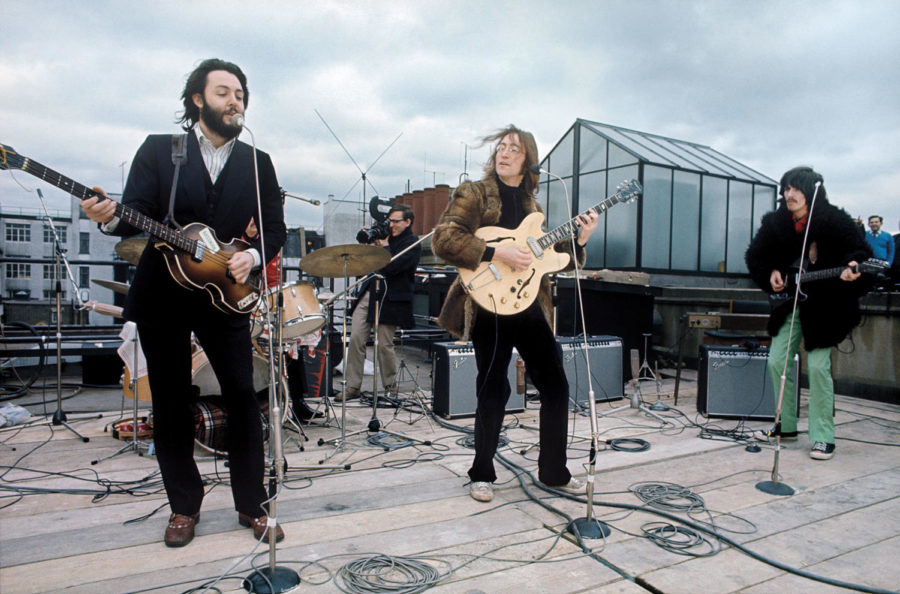“Get Back” immerses viewers in the world of the Beatles
Courtesy of Ethan A. Russell/Apple Corps Ltd.
New music documentary gives fans a multidimensional view of the iconic band.
“The Beatles: Get Back” is a rare kind of music documentary—unlike most, it actually shows how music is made. Using the most famous and influential band of all time, the Beatles, the documentary mini-series shows exactly what goes into the musical creative process, starting from the birth of songs, through the rehearsals, all the way to the final show. All along the way we see how John Lennon, Paul McCartney, George Harrison and Ringo Starr all interacted as they worked on the album “Let It Be,” humanizing them in a way never before possible. The thing about working on a project such as this is that, even if you are as talented as the Beatles, it doesn’t come easy. To the contrary, we can see just how arduous and painstaking the recording process is, and this is reflected in the documentary’s runtime and pacing. At almost eight hours, the three-episode series has a glacial pace, but as a result it is true to how the experience actually would’ve been and allows the viewer to fully become sucked into the world of the Beatles.
Directed by Peter Jackson, this project came about after the “Lord of the Rings” mastermind was given access to 60 hours of previously unreleased archival footage along with 150 hours of audio, all documenting the studio sessions for a project titled “Get Back.” The Beatles themselves didn’t quite know what they exactly wanted to do, but the goal was to return the band to its roots, with a more stripped down production for all tracks that would all be able to be performed live.
The documentary takes place in 1969. The Beatles hadn’t done a live show in a few years after growing tired of the constant chaos that followed them wherever they went. As a result they retreated away to the studio, allowing them to spend more time on their music and utilize all sorts of production wizardry to make groundbreaking albums like 1967’s “Sgt. Pepper’s Lonely Hearts Club Band” and 1968’s “The Beatles”—universally known as The White Album—that pushed popular music to become much more complex and artistic. But the recording sessions for the latter were so divisive, with the band members’ individual artistic leanings becoming more apparent and leading to such tension that the band decided to go back to basics and see if they could just make a good rock ‘n’ roll record again and reconnect with each other once more. Hiring director Michael Lindsay-Hogg, the Beatles had a camera crew capture the entire process as they aimed to come up with over a dozen songs in only a few weeks and perform their first live show in years to cap it all off.
Despite these intentions, it is commonly understood by Beatles historians that these January 1969 sessions were an unmitigated disaster, with animosity between band members at an all-time high. George Harrison even quit the band for a few days in the middle. Though the band would come together one more time to record the fantastic “Abbey Road” before breaking up, the animosity of the “Get Back” sessions seems to have led to the initial project being shelved. The album collected dust until 1970 when it was rejiggered by producer Phil Spector into an orchestra and choir-heavy record, deviating from the original spirit of the project. Retitled “Let It Be,” the album finally came out in May 1970, weeks after confirmation of the band’s breakup became official. Accompanying it was Lindsay-Hogg’s documentary, also titled “Let It Be,” which seemed to showcase just exactly why the band broke up in the first place, with the personal dynamics between the Beatles seemingly strained throughout the film. The Beatles were dead and “Let It Be” acted as the tombstone.
Now over 50 years later, Jackson seeks to reset the negative narrative surrounding the project, utilizing Lindsay-Hogg’s unused footage to give a more complete portrait of the group while also showcasing just how the band operated. Jackson says, “the reality is very different to the myth … Sure, there’s moments of drama—but none of the discord this project has long been associated with.” In his effort to showcase this different side of the band, Jackson spent four years restoring footage and remastering audio to better conversations between the band members, with the extra footage showing the tension of the times, but also showing the joy that the Beatles had and the true friendship they shared. The result is a sprawling epic told by the band members themselves as they raced to write, rehearse and perform all this new music, all while managing their interpersonal relationships to keep the band afloat.
Broken into three episodes, the series chronicles the entire project in great detail, allowing viewers to truly sit in the room with the Beatles and observe all their interactions, their constant work, as well as their true moments of genius. The first episode focuses on the early troubled sessions at Twickenham Studios before culminating in Harrison’s walkout. The second episode then delves into the band’s efforts to get Harrison back as well as the relocation to the more homely Apple Studios, with more jovial rehearsals arising as a result. The third episode largely deals with the preparations for the live show itself, and then the legendary rooftop concert, where the band performed live for the last time above the streets of London before being shut down by the police. Throughout we can see the true brotherly love between the members, despite their growing estrangement. Yes, McCartney was growing more bossy, Lennon was becoming more detached, Harrison was feeling more overlooked and Starr was just wanting everyone to get along, but between the bickering is a true kinship hard to find anywhere. The banter between the four is often hilarious and self-referential, really giving an observer the impression that despite the inevitability of the band’s separation, it really seemed like they all wanted to make it all work.
Between all the newly unearthed interactions are the continual rehearsals as the Beatles drove forward toward perfecting their songs. All of this plays out in almost real time, demonstrating the entire process of writing a song, rehearsing it over and over again and then performing it. Some of the best moments of the film are in showing how exactly some of their classics came to life. One sequence in particular showcases McCartney strumming away on his bass guitar when he starts snatching a melody, seemingly from thin air, and suddenly the bones of the song “Get Back” are there, with Starr clapping along and Harrison adding a few notes. The song, and many others, continue to evolve over the entire documentary, with the band figuring out how the lyrics should go, what sort of drumbeat should go along with it, the structure of the guitar chords that it should have, with all this work culminating in a spectacular performance on the rooftop.
It’s the little moments like this in this gigantic endeavor that make the series so special, and there are so many of them. It’s hard to believe moments like McCartney figuring out the structure to “Let It Be” on the piano while Lennon discusses set design for the show, or Harrison helping Starr figure out the chord progression to “Octopus’s Garden,” have been caught on film, yet there they are.
It’s also quite interesting how aware of their own problems the band seems to be, with all the members referencing their own history and acknowledging their struggles in recent years with each other. The most revealing moments happen following Harrison’s departure, after which sheer pandemonium reigns with the remainder of the band going wild on their instruments, Yoko Ono wailing on the microphone and McCartney doing parkour on the set. The next day, when it is uncertain whether Harrison will come back and whether the band can survive, McCartney’s true exasperation is captured as he struggles to hold back tears when discussing the future. A conversation later that day secretly recorded between McCartney and Lennon as they discussed how their egos had blinded them to Harrison’s discontent was another moment where I could not believe what I was privy to.
All this adds up a complete humanization of all four members of the band. We see their work processes, their struggles, their moments of joy, but most of all, their love for each other. It’s that feeling of love that made their music so special, and to see it on screen so completely fleshed out is a gift that Beatles fans can’t miss. For a few hours, viewers can truly live with the Beatles and see firsthand what made them so special, as well as why they fought so hard to stay together. After spending so much time with them and being immersed in their world, viewers get a true sense of who they are and what made all of them tick. The break up of the band may have been inevitable as they all grew in different directions, but in this moment captured forever by this documentary we see a group of friends working to get back to each other. Just for that, “Get Back” is something to be treasured for years to come.
All three episodes of “The Beatles: Get Back” are available to watch on Disney+.

Shreyas (he/him) is a fourth-year student majoring in biology and philosophy. If he isn't yammering to you about how great "Pet Sounds" is or making bad...


